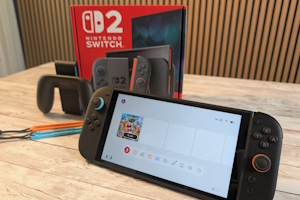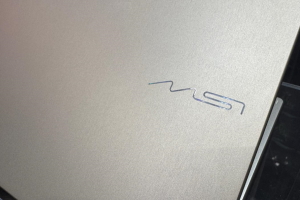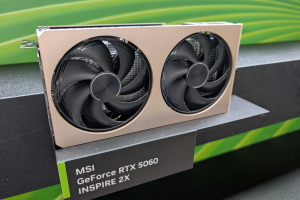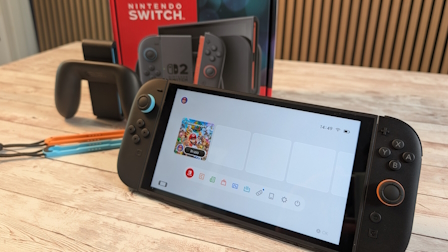Resistance: Fall of Man solo in 720p

Il promettente sparatutto 3D di Insomniac è stato più volte candidato per essere uno dei titoli lancio PlayStation 3 a supportare la risoluzione 1080p.
di Rosario Grasso pubblicata il 20 Ottobre 2006, alle 17:45 nel canale VideogamesPlaystationSony










 Microsoft Surface Pro 12 è il 2 in 1 più compatto e silenzioso
Microsoft Surface Pro 12 è il 2 in 1 più compatto e silenzioso Recensione REDMAGIC Astra Gaming Tablet: che spettacolo di tablet!
Recensione REDMAGIC Astra Gaming Tablet: che spettacolo di tablet!  Dopo un mese, e 50 foto, cosa abbiamo capito della nuova Nintendo Switch 2
Dopo un mese, e 50 foto, cosa abbiamo capito della nuova Nintendo Switch 2 Firefox va in crash? Potrebbe essere colpa della tua CPU Intel Raptor Lake
Firefox va in crash? Potrebbe essere colpa della tua CPU Intel Raptor Lake Nintendo Switch 2 è in offerta su AliExpress: si compra solo qui a 469€ con Mario Kart World
Nintendo Switch 2 è in offerta su AliExpress: si compra solo qui a 469€ con Mario Kart World Nicola Armaroli vs Federico Rampini: scontro a distanza sull'auto elettrica e l'inquinamento
Nicola Armaroli vs Federico Rampini: scontro a distanza sull'auto elettrica e l'inquinamento POCO F7 a 305€ su AliExpress: Snapdragon 8s Gen 3 e batteria da 6500 mAh. Perché a questo prezzo è il best buy del momento
POCO F7 a 305€ su AliExpress: Snapdragon 8s Gen 3 e batteria da 6500 mAh. Perché a questo prezzo è il best buy del momento 'I giochi appartengono a chi li acquista', interviene il vicepresidente del Parlamento europeo
'I giochi appartengono a chi li acquista', interviene il vicepresidente del Parlamento europeo iPhone 17 Pro/Pro Max in arrivo con colori più decisi e addirittura uno strano 'rame/arancio'
iPhone 17 Pro/Pro Max in arrivo con colori più decisi e addirittura uno strano 'rame/arancio' Offerte tablet Samsung: Galaxy Tab A9+ da 149€, ma c’è anche il potentissimo Tab S10 Ultra da 14,6'' in sconto
Offerte tablet Samsung: Galaxy Tab A9+ da 149€, ma c’è anche il potentissimo Tab S10 Ultra da 14,6'' in sconto Addio bambini su TikTok e Instagram in Italia: saremo fra i primi a testare la verifica dell'età
Addio bambini su TikTok e Instagram in Italia: saremo fra i primi a testare la verifica dell'età Bosch non ci sta e sfida le low cost: ecco la super scopa elettrica accessoriata della serie 6 a 159€
Bosch non ci sta e sfida le low cost: ecco la super scopa elettrica accessoriata della serie 6 a 159€  Harry Potter, la serie TV HBO ha una data di uscita e la prima immagine del protagonista sul set
Harry Potter, la serie TV HBO ha una data di uscita e la prima immagine del protagonista sul set Gli sconti Narwal su Amazon proseguono dopo il Prime Day: robot top di gamma fino a 400€ in meno, ma solo fino al 20 luglio
Gli sconti Narwal su Amazon proseguono dopo il Prime Day: robot top di gamma fino a 400€ in meno, ma solo fino al 20 luglio Dreame Aqua10 Ultra Roller Complete è il nuovo robot che pulisce da solo il mop: ecco come funziona
Dreame Aqua10 Ultra Roller Complete è il nuovo robot che pulisce da solo il mop: ecco come funziona Office su Windows 10: stop a nuove funzionalità dal 2026, arriveranno solo su Windows 11
Office su Windows 10: stop a nuove funzionalità dal 2026, arriveranno solo su Windows 11 Che portatile da favola: Asus Zenbook 14, OLED 3K, Intel Core Ultra 7, 32GB RAM, 1,2Kg torna a soli 1.099€
Che portatile da favola: Asus Zenbook 14, OLED 3K, Intel Core Ultra 7, 32GB RAM, 1,2Kg torna a soli 1.099€




















33 Commenti
Gli autori dei commenti, e non la redazione, sono responsabili dei contenuti da loro inseriti - infoPAL = 720x576 = 414.720 pixel
NTSC = 640x480 = 307.200 pixel
720P = 1280x720 = 921.600 pixel
1080I = 1920x540 = 1.036.800 pixel
1080P = 1920x1080 = 2.073.600 pixel
1600x1200 = 1.920.000 pixel
capito ^__^
IMHO 720P è il miglior compromesso tra qaulità/performance per questa generazione di console, 1080P è un po troppo "radicale" come soluzione, è un po come se appunto tutti volessimo giocare a 1600x1200 10 anni fa quando avevamo un bel monitor da 15'' crt al massimo a 1024 (magari persino interlacciati)
Poi volevo fare una domanda: ho letto nei primi post commenti sulla possibilità di ridurre i filtri, sopratutto l'AA per migliorare le prestazioni, ma se il gioco (come ormai praticamente tutti i giochi next-gen) avrà le HDR, l'AA non dovrebbe essere disattivato comunque a causa dell'architettura nvidia?
almeno è uno delle poche volte che la questione 720 vs 1080 viene affrontata da un punto di vista tecnico e non solo fanboy vs fanboy
**************************************************
I was talking to Bruce Dawson, one of our senior software design engineers here, about some questions I had around 1080i and 1080p. Frankly, I was particularly curious about why Sony has continued harping on 1080p as being "TrueHD", especially since the 360 has enabled 1080p output as well (coming soon to homes near you!) I was trying to figure out if I was just missing something, and his emailed answer was particularly clear and helpful to me, and since there's nothing confidential here I thought I'd share it with you.
The really interesting statistic that popped for me is how much less time a game console has to render a 1920x1080 scene versus a 1280x720 scene. (Remember this is on the same console, whichever one you like. This is not a comparison of different console's rendering capabilities to each other.) Simply put, for a 1080i/p game the console has 55% less time per pixel to render any special effects, anti-aliasing, illumination, etc. than for a 720p game. Yes, even Resistance has fallen off the bandwagon and admitted they can't hit 1080i/p as previously claimed. (It also helps explain why Gran Turismo HD is so underwhelming.)
Anyway, Bruce's text is below. Hope it helps clarify a few things for you!
Many developers, gamers, and journalists are confused by 1080p. They think that 1080p is somehow more challenging for game developers than 1080i, and they forget that 1080 (i or p) requires significant tradeoffs compared to 720p. Some facts to remember:
2.25x: that’s how many more pixels there are in 1920x1080 compared to 1280x720
55.5%: that’s how much less time you have to spend on each pixel when rendering 1920x1080 compared to 1280x720—the point being that at higher resolutions you have more pixels, but they necessarily can’t look as good
1.0x: that’s how much harder it is for a game engine to render a game in 1080p as compared to 1080i—the number of pixels is identical so the cost is identical
There is no such thing as a 1080p frame buffer. The frame buffer is 1080 pixels tall (and presumably 1920 wide) regardless of whether it is ultimately sent to the TV as an interlaced or as a progressive signal.
1280x720 with 4x AA will generally look better than 1920x1080 with no anti-aliasing (there are more total samples).
A few elaborations:
Any game could be made to run at 1920x1080. However, it is a tradeoff. It means that you can show more detail (although you need larger textures and models to really get this benefit) but it means that you have much less time to run complex pixel shaders. Most games can’t justify running at higher than 1280x720—it would actually make them look worse because of the compromises they will have to make in other areas.
1080p is a higher bandwidth connection from the frame buffer to the TV than 1080i. However the frame buffer itself is identical. 1080p will look better than 1080i—interlaced flicker is not a good thing—but it makes precisely zero difference to the game developer. Just as most Xbox 1 games let users choose 480i or 480p, because it was no extra work, 1080p versus 1080i is no extra work. It’s just different settings on the display chip.
Inevitably somebody will ask about field rendering. Since interlaced formats display the even lines on one refresh pass and then the odd lines on the next refresh pass, can’t games just render half of the lines each time? Probably not, and even if you could you wouldn’t want to. You probably can’t do field rendering because it requires that you maintain a rock solid 60 fps. If you ever miss a frame it will look horrible, as the odd lines are displayed in place of the even, or vice-versa. This is a significant challenge when rendering extremely complex worlds with over 1 million pixels per field (2 million pixels per frame) and is probably not worth it. And, even if you can, you shouldn’t. The biggest problem with interlaced is flicker, and field rendering makes it worse, because it disables the ‘flicker fixer’ hardware that intelligently blends adjacent lines. Field rendering has been done in the past, but it was always a compromise solution.
Devi effettuare il login per poter commentare
Se non sei ancora registrato, puoi farlo attraverso questo form.
Se sei già registrato e loggato nel sito, puoi inserire il tuo commento.
Si tenga presente quanto letto nel regolamento, nel rispetto del "quieto vivere".